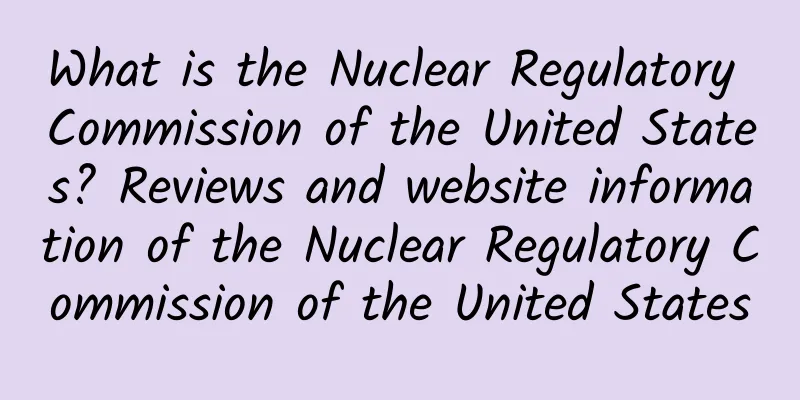What is the Nuclear Regulatory Commission of the United States? Reviews and website information of the Nuclear Regulatory Commission of the United States

|
What is the website of the Nuclear Regulatory Commission of the United States? The Nuclear Regulatory Commission (NRC) is an independent agency of the US government. It was established in 1975 and is headquartered in Rockville, Maryland. It is mainly responsible for regulating the safety, operation, and licensing of nuclear reactors, nuclear materials, and nuclear waste. Website: www.nrc.gov The Nuclear Regulatory Commission (NRC) is an independent agency of the U.S. government established in 1975. Its main responsibility is to ensure that the impact of nuclear energy on public health, safety and the environment is minimized during its use. As one of the benchmarks in the field of nuclear energy regulation in the world, NRC plays a vital role in the safety management and policy formulation of the nuclear energy industry. This article will explore in depth the background, functions, organizational structure, regulatory mechanism of NRC and its position in the development of global nuclear energy. The official website of the NRC ( www.nrc.gov ) is an important platform for the public to obtain relevant information. Through this website, users can learn about the core mission of the NRC, the latest regulatory developments, and policies and regulations related to nuclear energy. Both professionals and the general public can find information about nuclear safety, license application procedures, accident response measures, etc. Next, we will analyze in detail the background of the establishment of the NRC, the scope of its functions, and the specific ways in which it achieves its goals. 1. Background and History of NRCThe establishment of the U.S. Nuclear Regulatory Commission stems from the growing concern about nuclear safety. In the mid-20th century, with the rapid development of nuclear energy technology, the widespread use of nuclear reactors and radioactive materials triggered public concerns about safety and environmental protection. To address these issues, the U.S. Congress passed the Energy Reorganization Act in 1974, deciding to separate the safety regulatory functions originally undertaken by the Atomic Energy Commission (AEC) and establish an independent agency - NRC. The NRC was formally established in 1975 and is headquartered in Rockville, Maryland. Its establishment marks the U.S. government's high attention to nuclear safety regulation and also reflects the government's determination to balance nuclear development and environmental protection. The establishment of the NRC has made the safety regulation of the nuclear energy industry more professional and transparent, thereby enhancing the public's trust in nuclear energy technology. II. Main Functions of NRCThe core mission of the NRC is to protect public health and safety while safeguarding the environment from the effects of nuclear energy-related activities. To achieve this goal, the NRC has a number of important functions:
In addition, the NRC is responsible for regulating the treatment and storage of nuclear waste. With the operation of nuclear power plants, the generation of large amounts of radioactive waste has become an important issue. The NRC has established strict waste management standards to ensure that these wastes are properly handled and do not pose a threat to the environment or humans. 3. Organizational Structure of NRCThe NRC's organizational structure is designed to ensure the effective performance of its functions. The agency is composed of five commissioners, one of whom serves as the chairman. All commissioners are nominated by the President of the United States and must be confirmed by the Senate. This appointment mechanism guarantees the independence and authority of the NRC. NRC has multiple departments and offices, each with clear division of responsibilities. For example, the Office of Nuclear Reactor Safety is responsible for supervising the operation of nuclear power plants; the Office of Nuclear Materials Safety and Mineral Resources focuses on the management of radioactive materials. In addition, NRC also has the Office of Legal Affairs and the Office of International Affairs to support its extensive regulatory activities. In addition to the central agency, NRC has regional offices across the country to better monitor nuclear facilities in various places. The staff of these offices communicate and coordinate directly with local nuclear facilities to ensure the efficient implementation of regulatory work. IV. NRC’s Regulatory MechanismNRC's regulatory mechanism is known for its rigor and scientific nature. The following are some key regulatory measures:
It is worth mentioning that the NRC's regulatory mechanism is not static, but is constantly adjusted and optimized with technological progress and industry changes. For example, in the wave of digital transformation in recent years, the NRC has begun to use big data and artificial intelligence technologies to improve regulatory efficiency and accuracy. 5. NRC’s Position in Global Nuclear Energy DevelopmentAs one of the world's leading nuclear energy regulatory agencies, the NRC has a significant influence on the development of global nuclear energy. The standards and specifications it formulates often become templates for other countries and regions to learn from. In addition, the NRC also promotes the improvement of global nuclear energy safety levels through participation in multilateral organizations such as the International Atomic Energy Agency (IAEA). The successful experience of NRC shows that an independent and professional regulatory agency is essential to ensuring nuclear energy safety. It can not only effectively respond to domestic nuclear energy challenges, but also contribute wisdom and strength to global nuclear energy governance. VI. ConclusionThe U.S. Nuclear Regulatory Commission (NRC) is an important pillar of the U.S. government in the field of nuclear safety regulation. Since its establishment in 1975, the NRC has been committed to protecting public health and safety while promoting the sustainable development of nuclear energy technology. Through strict license approval, daily supervision, accident prevention and response measures, the NRC ensures the safe operation of nuclear facilities. In the future, as the global demand for clean energy grows, the importance of nuclear energy will become more prominent. NRC will continue to leverage its professional advantages to meet new challenges and safeguard the healthy development of the nuclear energy industry. At the same time, the public can also visit the official website of NRC ( www.nrc.gov ) to learn more about the work of this agency and its contribution to nuclear energy safety. |
>>: How is the British Daily Telegraph? British Daily Telegraph reviews and website information
Recommend
Steps for making monk fruit sword flower soup
Everyone knows that monk fruit is a traditional C...
What is the Townsville Daily like? Reviews and website information of the Townsville Daily
What is the Townsville Bulletin website? The Towns...
What is the American Medical Association like? American Medical Association reviews and website information
What is the American Medical Association website? ...
International Council of Museums_ICOM How is it? International Council of Museums_ICOM reviews and website information
International Council of Museums_What is ICOM? The...
Ingredients and steps for oyster tofu soup
Oysters are also called raw oysters. Oysters are ...
Fangfeng porridge
How much do you know about Fangfeng Congee? Let m...
Vegetable porridge recipe and benefits
Vegetable porridge is a dish that is especially s...
What is the Israeli newspaper Haaretz like? Reviews and website information of the Israeli newspaper Haaretz
What is the website of Israel's Haaretz? Haare...
The efficacy and function of drinking grapefruit peel soaked in water
Grapefruit peel is the peel of the fruit grapefru...
What are the benefits of eating noodles?
Dried noodles are one of the most common ingredie...
How to make oatmeal apple porridge
I believe everyone is familiar with the method of...
What is the South Waikato News like? South Waikato News reviews and website information
What is the South Waikato News website? South Waik...
Apple Juice
There are two types of apple juice: cloudy apple ...
How is Harman International Industrial? Harman International Industrial Review and Website Information
What is the website of Harman International Indust...
How is Liu Inna? Liu Inna's review and website information
What is Yoo In-Na? Yoo In-Na (Korean: 유인나; English...









